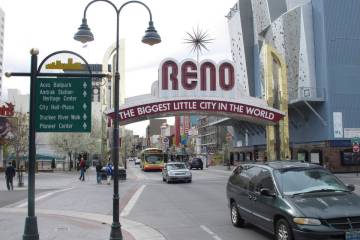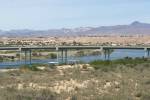SNWA could lease water to drought-stricken California
The Southern Nevada Water Authority would dip into its reserves to lease water to drought-stricken California under a plan slated for a vote by the agency's board Thursday.
Under the deal, the Metropolitan Water District of Southern California would pay the authority almost $44.4 million for 150,000 acre-feet of water, half of Nevada's annual share of the Colorado River.
To free up that much water for California this year, the authority plans to withdraw about 75,000 acre-feet of unused Colorado River water from its virtual bank account in Lake Mead and send it downstream through Hoover Dam.
The authority could either keep the cash and let California keep the water, or repay some or all of the money and get a proportional share of water in return.
Authority general manager John Entsminger called the arrangement a "win-win" for both Nevada and California, and further proof of the sort of "institutional flexibility" and interstate cooperation needed to weather ongoing drought on the overtaxed Colorado.
"We're not going to solve the river's problems without partners," he told the Review-Journal's editorial board on Tuesday.
Under the deal with California, Entsminger said the authority essentially would be transferring water from one bank to another — one with better terms and no restrictions on withdrawals.
Water the authority now stores in Lake Mead as so-called "intentionally created surplus" is subject to evaporation losses that reduce the total by 3 percent per year, so the longer the agency waits to tap the account the less water will be left in it.
By contrast, any water the authority banks in California wouldn't be subject to evaporation charges, Entsminger said, and they could take it back at any time, even during a federally declared shortage that would prevent withdrawals from their Lake Mead account.
"It makes a lot of sense from a water resource perspective," he said.
California gets some additional water in a crisis.
"What we're doing is helping them make time to do things that can take a decade and cost billions of dollars," Entsminger said.
In April, the Metropolitan Water District of Southern California cut water deliveries to its 26 member utilities by 15 percent as part of statewide mandatory conservation measures.
Met, as the agency is commonly known, supplies about half of the water used by 19 million Southern California residents between Mexico and Oxnard, north of Los Angeles, and from the coast to the Inland Empire.
Entsminger said Met generally gets about half its water from the Colorado River and half from the Sierras by way of California's 500-mile State Water Project, but the mountain range is in a drought some researchers call the worst in at least 500 years. As a result, Entsminger said, Met has gotten "zero" from from the State Water Project over the past two years.
If board members for the two agencies approve the agreement, the water and the money would change hands later this year. The SWNA board will consider the matter when it meets at 9 a.m. Thursday at the authority's downtown headquarters.
Met's board is expected to vote on the agreement later this month.
Entsminger said the $44,375,000 from Met would be placed in the authority's rate-stabilization fund and could be used to help pay for current or future infrastructure projects.
He added that the community currently has some water to spare. Even under the worst-case projection — a sharp rise in demand coupled with severe shortages on the Colorado River — the community likely won't need to dip into its water reserves for a decade at least.
Nevada has been banking unused Colorado River water in California since 2004. So far, the authority has socked away 205,225 acre-feet with Met for future use.
The authority's total reserves include about 1.5 million acre-feet of water in various accounts and reservoirs.
One acre-foot is enough to supply at least two average valley homes for one year.
Nevada gets 300,000 acre-feet from the Colorado each year, the smallest share by far among the seven states that draw from the river. California enjoys the largest share at 4.4 million acre-feet, roughly 1 million of which goes to Met.
Sending an additional 150,000 acre-feet to California from Lake Mead this year would cause the surface of the shrinking reservoir to drop an extra 1.5 to 2 feet.
Contact Henry Brean at hbrean@reviewjournal.com or 702-383-0350. Find him on Twitter: @RefriedBrean






























